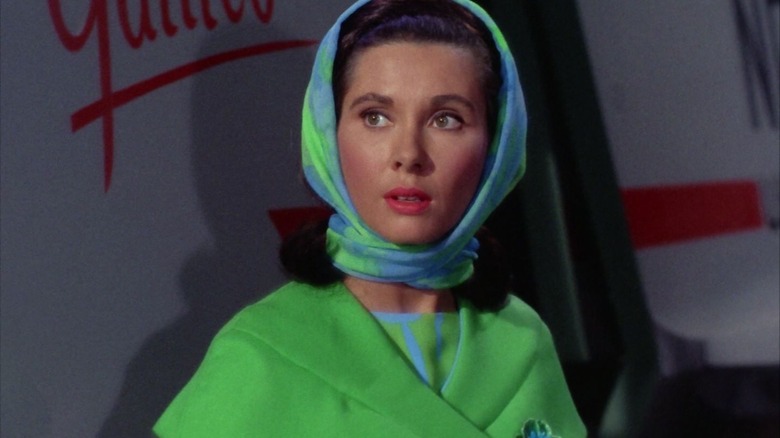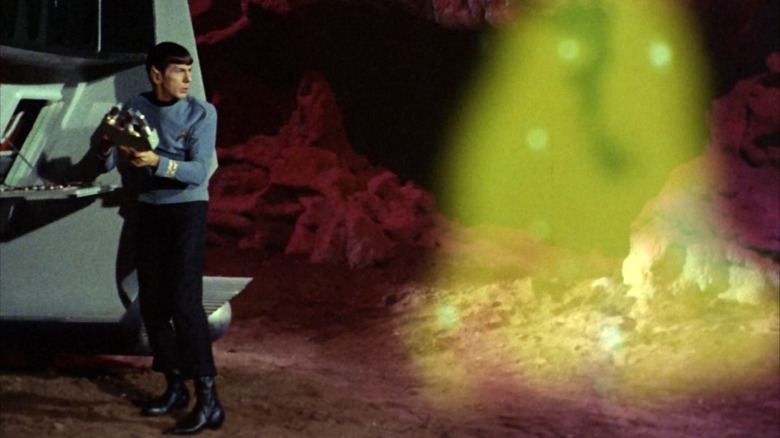Elinor Donahue Played An Unseen Second Role In Star Trek's Metamorphosis Episode
In the "Star Trek" episode "Metamorphosis" (November 10, 1967), an important dignitary named Commissioner Nancy Hedford (Elinor Donohue) is being transported to the U.S.S. Enterprise to undergo a complex medical procedure that can only be performed on the ship. She is afflicted with a fast-moving condition called Sukaro's Disease which, if not treated, could prove fatal within a few days, even though Commissioner Hedford has no discernible symptoms. Unfortunately for her, Hedford's shuttle is randomly attacked by a shape-shifting blob of energy and pulled down to the surface of a nearby planet. Captain Kirk (William Shatner), Spock (Leonard Nimoy), and Dr. McCoy (DeForest Kelley) have to find a way to repair the shuttle and get the Commissioner back to the Enterprise before her condition worsens.
They are not alone on the planet. Zefram Cochrane (Glenn Corbett) is living there. This is unusual, as Zefram Cochrane — the inventor of faster-than-light travel (who was played by James Cromwell in "Star Trek: First Contact") — presumably died a century earlier. How is he alive? It seems the same blob that pulled the shuttlecraft out of the heavens is a living entity that Cochrane calls the Companion. The Companion has been able to read his thoughts and provide him with a long life and sustenance. It now seeks to provide him with company, hence its kidnapping of several passersby.
The Companion, we later learn, is also in love with Cochrane. The Enterprise crewmates manage to tinker with their universal translators to communicate with the Companion, and it admits that it wants to stay with Cochrane forever.
An uncredited Lisabeth Hush provided the voice of the Companion in the episode's final cut, but on set, Shatner and Corbett needed someone to interact with. Luckily, Donohue was more than willing to step in. She recalled her experience working on "Metamorphosis" in a 2016 interview with StarTrek.com.
Elinor Donohue read the Companion's lines on set
Donohue knew that the voice of the Companion would be dubbed over later, so her on-set participation was only to provide William Shatner with a frame of reference. She was asked by the episode's director, Ralph Senensky, to read the Companion's lines right when she was about to go home. As she recalled it:
"I was there and I don't quite know why I was there. Maybe I'd shot something in the morning and was released for the rest of the day. It was near lunch time and I'd decided to go have lunch. They started to set up for that scene and I believe it was the director, who said, 'Would you mind, if you're going to be here, but you don't have to be, climbing up on the ladder and reading the lines?' I said, 'Oh, I'd love to.'"
Donohue had to climb a ladder to read the lines because Shatner addressed the Companion by craning his neck up to look at the Companion. On a ladder, the two could have a proper conversation. Donahue continued:
"I thought it was wonderful fun, because there was no pressure on me to perform anything, so to speak. It was just an opportunity to be helpful to a fellow actor, and, yes, [Shatner] was very appreciative. He seemed to smile and be very happy about my being up there."
Technically, Donohue was one of three actors to play the Companion. Initially, the dubbed voice of the Companion was provided by Elizabeth Rogers, who played Lieutenant Palmer in "The Doomsday Machine" (an episode that seemingly helped inspire "Star Trek: The Motion Picture") and "The Way to Eden." Senensky reportedly didn't like Rogers' line readings, so she was replaced by Lisabeth Hush, an actor best known for her appearance in "Thoroughly Modern Millie."
After "Star Trek," Donohue merely continued her prolific TV career.

